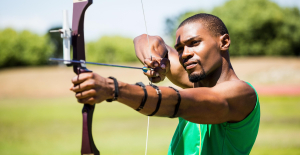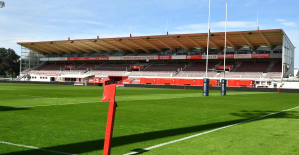172 inhabitants: Warth in Vorarlberg is one of the smallest winter sports resorts in Austria - and yet one of the most important. Because the remote Alpine village has a number of records to offer: guaranteed snow, almost endless slopes, an astonishing number of Olympic champions and a long history of skiing.
This series of superlatives makes Warth one of the most attractive destinations for skiers and snowboarders in the Alps. Which explains that 1700 beds are available for guests. If they are occupied, which is regularly the case in winter, there are ten times more tourists than locals in Warth.
Nevertheless, the highest town in Vorarlberg (1495 meters) has remained quiet and manageable. Today it no longer looks like it does on old postcards, on which Warth is shown as a handful of dark wooden houses scattered around the village church. But the mountain spot has retained its charm and has not followed the path of other winter hotspots that have developed into large-scale alpine parties, think of Sölden or Ischgl.
This is what you experience when you stroll through snow-covered Warth in the evening. In the alley next to the church, only your own footsteps can be heard. No fuss, no drunks singing and looking for their skis. There is no après-ski circus anywhere, instead people sit relaxed in the hotels at the bar with a drink.
It's also relaxed on the slopes during the day. Because the number of guests is limited voluntarily: "We don't give out more than 8,000 ski passes a day, that's the limit," says Mayor Stefan Strolz.
The most important reason for Warth's popularity: there was never a lack of snow. Since 2008, the winter sports region of Warth-Schröcken, which connects the two neighboring villages, has been called "the snowiest ski area in Europe". An English ski journalist had researched and compared measurement results and statistical data from several years throughout the Alps. Warth-Schröcken came off best: the long-term average of 10.70 meters of snow trickles down here every year – a record for the whole of the Alps.
"Of course, that doesn't mean that we have ten meters of snow on top of each other," explains Ulrike Schlierenzauer, owner of the "Berghotel Körbersee" and Warth's official snow measurer, "but how much it has snowed all winter." Schlierenzauer trudges to one every evening four meter high bar and a tool box behind their hotel. There she measures the amount of snow, snow temperature, wind strength and direction. The snow depth is currently 90 centimeters on the mountain and 50 centimeters in the valley.
The geographic location gives Warth a snow guarantee. Northwest stowage is the magic word. That means: If heavy rain clouds come from the north-west, i.e. from the Atlantic, they meet their first obstacle on the Arlberg. And throw off ballast in the form of snow. A blessing for Warth, which is directly below, just in front of the Arlberg.
It's not just the amount of snow that makes Warth attractive to skiers, but also its quality. Since most of the slopes face north, the snow has a good grip, it doesn't melt in the sun into a jelly mass that you have to plow through with a lot of force, which reduces the fun of driving and increases the risk of falling.
Another plus point: the amount of snow offers freeriders great opportunities to smash through deep snow off the slopes above the tree line. The local ski schools offer beginners special freeride courses.
However, sometimes it snows too much in Warth. In the winter of 1999 "we were cut off, we were on our own for 16 days," remembers Mayor Strolz. Back then, avalanches thundered down into the valley. The avalanche danger in Vorarlberg has been calculated since the mid-1950s so that nobody is harmed by the heavy snow. Warth-Schröcken shows the current avalanche warning level in the daily snow report on the website.
Skiing has been going on in Warth since the Imperial and Royal days, but the first ski lift was not built until the winter of 1953/54. In 1963 the first single chairlift was launched. He finally turned the mountain village into a tourist resort.
16 years later, the Hochalplift and the Jägeralpbahn connected Warth with the neighboring village of Schröcken - the Warth-Schröcken ski area now has 62 kilometers of slopes. The Auenfeldjet followed in 2013 – the two-kilometre-long ten-seater gondola lift is a big asset because it connects Warth-Schröcken with Lech.
Warth is therefore part of Ski Arlberg, Austria's largest ski area. This offers 302 kilometers of marked runs for beginners as well as for experts, plus 200 kilometers of variants in open terrain; 87 gondolas and lifts are in operation.
Although almost eleven meters of natural snow fall, there are also snow cannons in the mountains in Warth. Why? Because skiers expect perfect slopes all season long, explains Günther Oberhauser, Managing Director of Skilifte Warth GmbH. Snow is made for a total of 72 hours per season, "then the 170,000 cubic meters of water from the reservoir are used up".
In Germany it is far too warm at the beginning of the year. Bad news for everyone who was looking forward to winter landscapes and perfect snow slopes. A tourist hotspot is already closed.
Source: WORLD
And what about rising energy prices? Oberhauser can't help but smile. Warth was lucky, he says. "We signed a new electricity contract in July 2021 for five years." Nevertheless, the price for a day ticket rose from 58 to 64 euros this winter compared to the same season last year.
Around the turn of the last century, people all over the Alps began to strap wooden boards to their feet. In Warth, the village priest Johannes Müller was the first. In 1894 he read in a magazine "how one could move on skis in the far north in the heaviest snow".
Pastor Müller was so enthusiastic that he ordered skis from Scandinavia. His motifs are handed down in the book "Ski History Warth". He wrote that skis were practical for the people of Warther "when every year there were not just days but weeks because of the amount of snow and the risk of avalanches, when nobody could leave the community and nobody could come into the community".
Müller practiced at night “so as not to be laughed at. I strapped on the 'Swedish', took the long stick and tried my luck in the big fresh snow. Yes - I was already lying with my skis across and my head in the snow and so on again and again until around midnight."
Müller didn't give up, and after a few days he dared "even before the villagers lit the first light, a trip to Lech. Apart from a few falls, I got over it after 1 ½ hours.” Father was not only a great visionary, but also the first freerider in Vorarlberg.
Today, guests in Warth can book a Pfarrer Müller tour with a ski guide. Experienced off-piste skiers board along the original route through the deep snow from the Wartherhorn saddle past brushes to Lech and via the Mohnenfluh north descent back to Warth.
1972 was a magical year for Warth: Wiltrud Drexel won bronze in Sapporo, she was Warth's first Olympic medalist. Drexel runs a guesthouse in Warth, easily recognizable by the Olympic rings on the facade. Locals proudly say: "She skis like a young girl."
Warth's second Olympian, Hubert Strolz, born in 1962 and related to Mayor Stefan Strolz, also has accommodation in the "Haus Hubertus". Visitors can book him as a ski guide, also for the Pfarrer-Müller tour.
He learned to ski on the “Käslift” at the alpine dairy in the middle of town, a simple pull lift that no longer operates. After fourth grade, he went to the ski boarding school in Schruns, also in Vorarlberg. "From the second year it was great, school and skiing," he says. Which brought him the Olympic victory in Calgary in 1988 in the combined.
His son Johannes went to ski school. But he flew out of the ski squad in 2021. He continued to train at his own expense and also won the gold medal in alpine combined in Beijing 2022, 34 years after his father. Father Strolz is still moved to tears when he talks about it.
Warth has dedicated a small exhibition to its three ski stars and is proud that every 57th resident now has an Olympic medal. Who knows if it would have happened if Pastor Müller hadn't gone ahead so courageously in 1894.
Arrival: The nearest train station is Reutte/Tyrol. From there, buses (vvt.at) go to Warth, taking about one hour and 45 minutes. Those arriving by car drive from Munich via Oberau, Plansee, Reutte, from Stuttgart via Füssen, Reutte or Lindau through the Bregenzerwald. The road from Lech to Warth is closed in winter.
Accommodation: "Hotel Walserberg", family-run four-star hotel, double room with breakfast in the winter high season from 381 euros, walserberg.at; "Berghotel Körbersee" at 1675 meters, double room with half board from 160 euros, koerbersee.at; "Pension Wiltrud" by Olympian Wiltrud Drexel, double room with breakfast from 118 euros, pension-wiltrud.at; "Haus Hubertus" by Olympic champion Hubert Strolz, apartment for two from 114 euros, hubertuswarth.at.
More information: The Warth-Schröcken ski area (warth-schroecken.at) is part of the largest Austrian winter area on the Arlberg (skiarlberg.at); austria.info
Participation in the trip was supported by the Warth-Schröcken ski area. You can find our standards of transparency and journalistic independence at axelspringer.com/de/Werte/downloads.

 United States: divided on the question of presidential immunity, the Supreme Court offers respite to Trump
United States: divided on the question of presidential immunity, the Supreme Court offers respite to Trump Maurizio Molinari: “the Scurati affair, a European injury”
Maurizio Molinari: “the Scurati affair, a European injury” Hamas-Israel war: US begins construction of pier in Gaza
Hamas-Israel war: US begins construction of pier in Gaza Israel prepares to attack Rafah
Israel prepares to attack Rafah Spain is the country in the European Union with the most overqualified workers for their jobs
Spain is the country in the European Union with the most overqualified workers for their jobs Parvovirus alert, the “fifth disease” of children which has already caused the death of five babies in 2024
Parvovirus alert, the “fifth disease” of children which has already caused the death of five babies in 2024 Colorectal cancer: what to watch out for in those under 50
Colorectal cancer: what to watch out for in those under 50 H5N1 virus: traces detected in pasteurized milk in the United States
H5N1 virus: traces detected in pasteurized milk in the United States Private clinics announce a strike with “total suspension” of their activities, including emergencies, from June 3 to 5
Private clinics announce a strike with “total suspension” of their activities, including emergencies, from June 3 to 5 The Lagardère group wants to accentuate “synergies” with Vivendi, its new owner
The Lagardère group wants to accentuate “synergies” with Vivendi, its new owner The iconic tennis video game “Top Spin” returns after 13 years of absence
The iconic tennis video game “Top Spin” returns after 13 years of absence Three Stellantis automobile factories shut down due to supplier strike
Three Stellantis automobile factories shut down due to supplier strike A pre-Roman necropolis discovered in Italy during archaeological excavations
A pre-Roman necropolis discovered in Italy during archaeological excavations Searches in Guadeloupe for an investigation into the memorial dedicated to the history of slavery
Searches in Guadeloupe for an investigation into the memorial dedicated to the history of slavery Aya Nakamura in Olympic form a few hours before the Flames ceremony
Aya Nakamura in Olympic form a few hours before the Flames ceremony Psychiatrist Raphaël Gaillard elected to the French Academy
Psychiatrist Raphaël Gaillard elected to the French Academy Skoda Kodiaq 2024: a 'beast' plug-in hybrid SUV
Skoda Kodiaq 2024: a 'beast' plug-in hybrid SUV Tesla launches a new Model Y with 600 km of autonomy at a "more accessible price"
Tesla launches a new Model Y with 600 km of autonomy at a "more accessible price" The 10 best-selling cars in March 2024 in Spain: sales fall due to Easter
The 10 best-selling cars in March 2024 in Spain: sales fall due to Easter A private jet company buys more than 100 flying cars
A private jet company buys more than 100 flying cars This is how housing prices have changed in Spain in the last decade
This is how housing prices have changed in Spain in the last decade The home mortgage firm drops 10% in January and interest soars to 3.46%
The home mortgage firm drops 10% in January and interest soars to 3.46% The jewel of the Rocío de Nagüeles urbanization: a dream villa in Marbella
The jewel of the Rocío de Nagüeles urbanization: a dream villa in Marbella Rental prices grow by 7.3% in February: where does it go up and where does it go down?
Rental prices grow by 7.3% in February: where does it go up and where does it go down? Even on a mission for NATO, the Charles-de-Gaulle remains under French control, Lecornu responds to Mélenchon
Even on a mission for NATO, the Charles-de-Gaulle remains under French control, Lecornu responds to Mélenchon “Deadly Europe”, “economic decline”, immigration… What to remember from Emmanuel Macron’s speech at the Sorbonne
“Deadly Europe”, “economic decline”, immigration… What to remember from Emmanuel Macron’s speech at the Sorbonne Sale of Biogaran: The Republicans write to Emmanuel Macron
Sale of Biogaran: The Republicans write to Emmanuel Macron Europeans: “All those who claim that we don’t need Europe are liars”, criticizes Bayrou
Europeans: “All those who claim that we don’t need Europe are liars”, criticizes Bayrou These French cities that will boycott the World Cup in Qatar
These French cities that will boycott the World Cup in Qatar Archery: everything you need to know about the sport
Archery: everything you need to know about the sport Handball: “We collapsed”, regrets Nikola Karabatic after PSG-Barcelona
Handball: “We collapsed”, regrets Nikola Karabatic after PSG-Barcelona Tennis: smash, drop shot, slide... Nadal's best points for his return to Madrid (video)
Tennis: smash, drop shot, slide... Nadal's best points for his return to Madrid (video) Pro D2: Biarritz wins a significant success in Agen and takes another step towards maintaining
Pro D2: Biarritz wins a significant success in Agen and takes another step towards maintaining


















